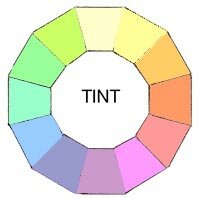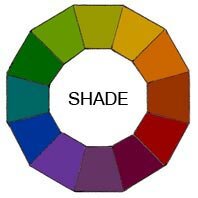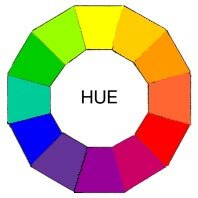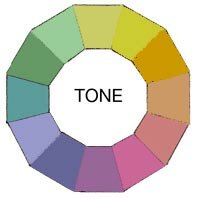(Questions that were the same were removed
2. How does black change in as a colour in low light?
It doesn't, black still stays black in lower light. It may appear darker as there's less contrast behind it however making it appear blacker through perception.
5. Do the names of colours change how we perceive them?
Strangely enough it actually does, a good example of this is the Himba tribe, they have half the colour categories as us and subsequently they have a more limited perception of the world around them.
Cutbit - Himba tribe colour experiment
6. Is White a colour within Additive light or is it considered a combination when you perceive it.
7. Is it better to make the background of something neutral so that the colours stand out more?
8. What colours do we see when we perceive black?
We don't see any colours when we perceive black, black objects absorb the full wavelength of the colour spectrum so what are actually seeing is the absence of light due to it been absorbed.
10. Why is colour necessary if we could live in black and white?
The eight questions we narrowed down:
1.Is colour more less or equally important than
typography in graphic design?
It would be more important, however that's subjective. I say this because colour can be used as a signifier for symbols, changing their colours can mean different things. This is recognisable instantly. Typography however isn't always necessary while taking into account colour is.
2.Is black a colour?
'To see color, you have to have light. When light shines on an object some colors bounce off the object and others are absorbed by it. Our eyes only see the colors that are bounced off or reflected.
The sun’s rays contain all the colors of the rainbow mixed together. This mixture is known as white light. When white light strikes a white crayon or marker barrel, it appears white to us because it absorbs no color and reflects all color equally. A black crayon or marker cap absorbs all colors equally and reflects none, so it looks black to us. While artists consider black a color, scientists do not because black is the absence of all color.'
So as crayola say's It depends on how you view it, for artists black can be considered a colour, as it's not physically speaking and taking light into the mix. While scientists see black as been the absence of light and to have colour you need light so black would not be considered a colour to them.
3.Why do people have favorite colours?
'Evolutionarily speaking, it makes sense that people would approach or withdraw from objects based on their colors. Bright reds and yellows often mean ripe, delicious fruit, whereas drab yellowish-greens and browns signal ... well, less pleasant things.' (1)
If you're a girl and you liked pink when you were younger, similarly blue for a boy it's most probably down to been surrounded by the colour at that age, as most things are coloured for genders. However children at the age of 12 months, before been to enveloped by this environment both go towards colours that are more reddish rather than blue surprisingly. (2) However when you grow up your favourite colour is representative to something that is pleasant to you or something that makes you feel safe.
If you're a girl and you liked pink when you were younger, similarly blue for a boy it's most probably down to been surrounded by the colour at that age, as most things are coloured for genders. However children at the age of 12 months, before been to enveloped by this environment both go towards colours that are more reddish rather than blue surprisingly. (2) However when you grow up your favourite colour is representative to something that is pleasant to you or something that makes you feel safe.
5.Why do natural colours fade?
Colours apparently fade due to ultraviolet light, interestingly enough! It's all a bit scientific but I found this which sums that up rather well.
'Ultraviolet rays can break down the chemical bonds and thus fade the color(s) in an object - it is a bleaching effect. Some objects may be more prone to fading, such as dyed textiles and watercolors. Other objects may reflect the light more, which makes them less prone to fade.'
So if you're after something that'll be in the sun, remember to make it plastic or metal they're alot more reflective to ultraviolet, where as textiles fade because of they absorb alot of them.
7.What's the best light to look at colour in?
It depends what colour you are observing, colours will be perceived differently under all lights. However the best place for looking at colour, that you can come back to is under a constant light. (Lightbulbs) Natural light outside is forever changing so trying to observe colour at noon won't be perceived the same as it is at dusk. So stay indoors.
8.Which colours look best together of them all?
There's no science to what the best to colours together are, using colour theory you could quickly find pairings of colours that go well together however such as Blue and Orange.
5 questions from other group:
1. Does looking at colour through one eye affect the way you see colour compared to the other eye?
As our eyes aren't exactly perfect, since nature rarely does anything identically our eyes have slightly more or less red, green or blue cones in either one of our eyes. This leads to our eyes seeing more of one colour than the other eye since it's more sensitive to that colour, an eye that sees red better has more red cones in it for example. The reason we don't see this imperfections when we're seeing through both eyes is because our brain is able to sort the good and cancel the bad out so that we can see without them, It's only when we look through one eye that we see these differences.
http://www.newscientist.com/blog/lastword/2008/03/rose-tinted-vision.html
2. What is the difference between tint and shade/ hue and tone?
Tint:

A tint is the whitening of a hue, it's any colour with white added into the mix.
Shade:

A shade is the blackening of a hue, it's any colour with black added into the mix.
Hue:

Hue is in reference to the colours themselves, so the root of Maroon would be Red. Hue is simply a way to describe a family of colours, likewise the word Hue and colour can be used interchangeably.
Tone:

A tone is the greying of a hue, it's any colour with black and white added into the mix.

A tint is the whitening of a hue, it's any colour with white added into the mix.
Shade:

A shade is the blackening of a hue, it's any colour with black added into the mix.
Hue:

Hue is in reference to the colours themselves, so the root of Maroon would be Red. Hue is simply a way to describe a family of colours, likewise the word Hue and colour can be used interchangeably.
Tone:

A tone is the greying of a hue, it's any colour with black and white added into the mix.
3. How crucial is it to learn colour theory?
I would it say it's pretty crucial especially when it comes to doing an art based degree formally, in essence it can be summed with this quote on it's purpose: "The principles of color theory are used to create color combinations that are considered harmonious to the eye." It's used to make e
4. Is it possible that there are colours that exist that the human eye cannot process?
I really like this question and it turns out, yes there is actually. 'Impossible colours' well colours we can't see, but do exist still. Easy to note examples such as infrared and ultraviolet exist, but there's also more colours than that. One way to attempt to perceive one of them is through the the boxes below, if you cross your eyes.

I really like this question and it turns out, yes there is actually. 'Impossible colours' well colours we can't see, but do exist still. Easy to note examples such as infrared and ultraviolet exist, but there's also more colours than that. One way to attempt to perceive one of them is through the the boxes below, if you cross your eyes.

5. Is colour theory learnt or is it just instinctive?
Colour theory is learnt, you can't just know about it without discovering it or finding it out. Same with the Laws of physics you're simply made aware and start to perceive it once you've been told of it. You may combine colours harmoniously instinctively but you won't be aware that what you would be doing is colour theory.

No comments:
Post a Comment